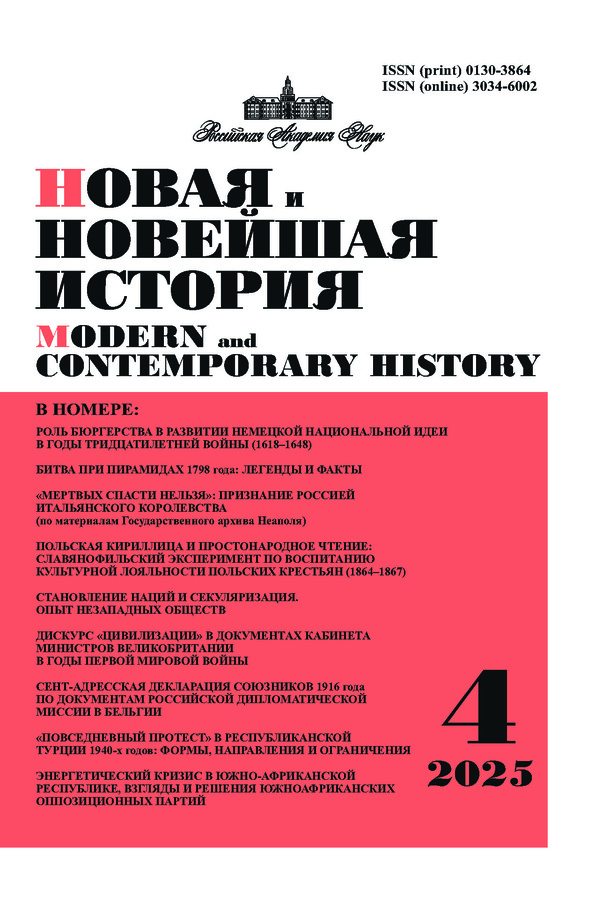Novaya i Novejshaya Istoriya
ISSN (print): 0130-3864
Media registration certificate: No. 0110133 dated 02/05/1993
Founder: Institute of General History RAS, Russian Academy of Sciences
Editor-in-Chief: Mirzekhanov Velikhan Salmankhanovich
Number of issues per year: 6
Indexation: RISC, list of Higher Attestation Commissions, CrossRef, White List (level 2nd), Scopus
«Modern and Contemporary History» is a leading Russian historical periodical devoted to the problems of modern and contemporary history, methodology, source studies and historiography of world history, as well as the history of international relations and foreign policy. The Journal brings together professional historians from all over the world dealing with the problems of world history, introduces readers to the most up-to-date research in both Russian and international historical science, and informs them of the most important scholarly events.
The Journal was founded by the Institute of World History of the Russian Academy of Sciences (Moscow) and the Russian Academy of Sciences (Moscow) itself. It is published six times a year and covers the problems of international political, economic, and social history, the theory and methodology of historical science, the history of international relations, and historiography. Considerable attention is paid to the publication of historical sources (documents, memoirs), coverage of events academic life, and scholarly criticism.
The Journal is included in the List of leading peer-reviewed scientific journals and publications recommended by the Higher Attestation Commission for the publication of doctoral theses. All articles published in the journal correspond to the Nomenclature of Specialties of Scientists, approved by Order No. 1027 of the of Ministry of Education and Science of Russia of October 23, 2017:
- 00.00 Historical Sciences and Archeology:
- 00.03 World History
- 00.09 Historiography, Source Study and Methods of Historical Research
- 00.10 History of Science and Technology
- 00.15 History of International Relations and Foreign Policy
Articles published in the journal are indexed by Scopus, the Russian Scientific Citations Index and RSCI Web of Science. In accordance with the international standard of scientific periodicals, each published article receives its unique DOI code (Digital Object Identifier).
最新一期
编号 4 (2025)
Theory and methodology of history
Nation-Building and Secularisation: Experiences of Non-Western Societies
摘要
 5-16
5-16


Kyrgyz National-State Formation at the Turn of the 1910s–1920s: Interpretations in the Historiography of Independent Kyrgyzstan
摘要
 17-26
17-26


Modern history
Liturgy, Confessional Identity, and Institutional Change: Lutheran and Reformed Liturgical Projects in the Reformation Era
摘要
 27-49
27-49


Burghers and the Formation of the German National Idea During the Thirty Years’ War, 1618–1648.
摘要
 50-64
50-64


The Battle of the Pyramids, 1798: Legends and Realities
摘要
 65-79
65-79


“The Dead Cannot Be Saved”: Russia’s Recognition of the Kingdom of Italy, Based on Sources from the State Archive of Naples
摘要
 80-96
80-96


Polish Cyrillic and Popular Reading: The Slavophile Experiment in Fostering Cultural Loyalty among Polish Peasants, 1864–1867
摘要
 95-109
95-109


20th century
The Discourse of “Civilisation” in British Cabinet Papers during the First World War
摘要
 110-132
110-132


The 1916 Declaration of Sainte-Adresse: Insights from the Russian Diplomatic Mission in Belgium
摘要
During the First World War, Belgium, whose permanent neutrality was violated by Germany, defended its territory and effectively fought alongside the Entente. Great Britain and France sought to secure a more active Belgian military role against Germany. However, King Albert I, unlike his government, opposed full integration of the Belgian army into the alliance, maintaining a policy of neutrality and desiring an early cessation of hostilities on Belgian soil. The monarch pursued peaceful settlement options, maintaining contacts not only with the Entente but also engaging in unofficial negotiations with Germany. Against this backdrop, in February 1916, Russia, Great Britain, and France signed the Declaration of Sainte-Adresse, which guaranteed Belgium’s participation in future peace negotiations and pledged support for its post-war recovery. This declaration, which elicited mixed reactions from Belgian leadership and society, has hitherto received little attention from Russian historians. Drawing on documents from the Russian diplomatic mission in Belgium held in the Archive of the Foreign Policy of the Russian Empire, as well as published personal correspondence of King Albert, the article analyses the preparation process of the declaration, reveals the aims of the Allies, their conception of Belgium’s role in the war and its place in the post-war order, and examines Russia’s involvement in its formulation. Furthermore, the article considers the Belgian leadership’s attempts to influence the final text of the document, the signing of which significantly shaped the country’s subsequent foreign policy trajectory.
 133-145
133-145


The Soviet Diplomatic Catastrophe in Beijing on April 6, 1927
摘要
 146-157
146-157


“Everyday Protest” in Republican Turkey of the 1940s: Forms, Trajectories, and Constraints
摘要
 158-174
158-174


The Issue of Arms Race Limitation in the Expert Memoranda of the Institute for USA Studies, USSR Academy of Sciences, Late 1960s – Early 1970s
摘要
 175-183
175-183


Contemporary history
The Energy Crisis in the Republic of South Africa: Opposition Perspectives and Proposed Solutions
摘要
 184-197
184-197


Messages
Yevgeny Tarle: Sketches Towards a Portrait in the Context of the Era
摘要
 198-209
198-209


The Particular Methodology of Historical Science
摘要
 210-218
210-218


Reviews
The Arab-Israeli Conflict and Soviet Foreign Policy (T.V. Nosenko. The Arab-Israeli Conflict in the View of Soviet Policy: Achievements and Losses (1950s–1967). M., 2023)
 219-222
219-222











